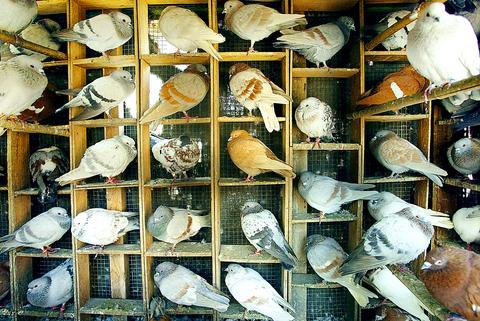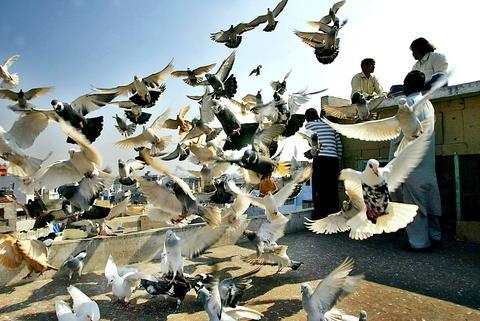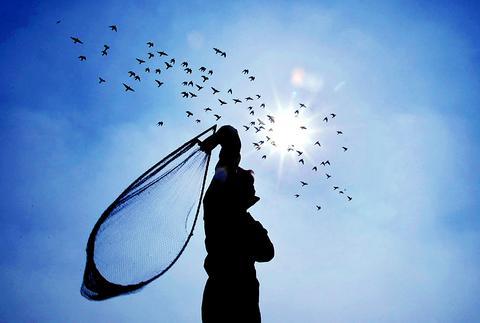When the sun is at its peak over the crumbling buildings of Delhi's old city and the midday call to prayer rings from a dozen mosques, a proud, soft-spoken man climbs three flights of steps to his uppermost rooftop.
There, amid the gentle cooing of hundreds of pigeons and the shouts of the men who love them, Allaudin becomes a master of the air, and a link to a disappearing sport of kings.
``These birds, they have feelings,'' says the graying man, a successful sweet shop owner who uses only one name. ``And I love these birds and they know that.''

PHOTO: AP
Kabooter baz, they are called -- Urdu for ``pigeon handlers.'' Men like Allaudin have been training pigeons for hundreds of years, since this warren of crowded, filthy streets was one of the most elegant neighborhoods in South Asia.
``This was a sport of kings and nawabs,'' says Allaudin, referring to the Muslim royals who once ruled over much of what is modern-day India. ``Not many people are doing it in the old ways anymore.''
In India, pigeon handling was long the pastime of gentlemen. It is also, perhaps, the gentlest of sports.

PHOTO: AP
Much of a kabooter baz's time is spent choreographing elaborate airborne dances: sending pigeons into the air, urging them to fly away and then calling them back with a cry of ``ahhhh-ohhhhh!'' and a hand motion like the scattering of seeds. In seconds, birds that were little more than distant speckles in the sky reappear in a gentle flapping of wings.
Only occasionally do things get overtly competitive, with races and contests and pigeon-swiping ploys, when one handler tries to lure someone else's birds into his flock.
But mostly, it's quiet daily rituals with the birds: feeding them, cooing to them, treating their ailments.

Or that is what it's like for men like Allaudin, a khalifa -- or master -- of the pigeon world. While there are thousands of pigeon handlers in old Delhi, there are only a few dozen khalifas, men who trained under earlier masters and for whom pigeon handling is a serious craft. To them, overt competition is crass.
``Young people today, they're not coming for the quality of the sport, but for the money and the competitiveness,'' Allaudin says sadly.
Not that he's truly above the competition. He laughs disdainfully about the skills of other pigeon handlers and says he wouldn't lower himself to visit another man's coops.
``I can call these people to my house,'' he says. ``But me going to them? Sorry.''
Once, hundreds of aristocrats and wealthy merchants flew pigeons from the rooftops of old Delhi, a maze of streets in a district that used to be the heart of a beautiful city.
These days, you have to squint to see the beauty, looking past dust as deep as a light snowfall, and scrap -- from broken pottery to mountains of car parts -- piled in the courtyards of centuries-old mansions.
It's a place where bicycle rickshaws navigate streets more like alleys, and where the alleys are so narrow you can reach out your arms and touch buildings on both sides.
It is only a few kilometers -- but an enormous economic leap -- to modern New Delhi, the southern neighborhoods carefully laid out by British colonial rulers in the early 1900s. As the city grew southward, sprouting districts of tree-shaded roads and bungalows, the center of power and money moved away from old Delhi, which has been largely left to the poor and the powerless.
Today, most Indians refer to the entire town as New Delhi, but the old city remains a world apart. It is poorer, far more crowded, and in an overwhelmingly Hindu nation it is dominated by Muslims. Life here revolves around the city's great mosque, and time is tracked by calls to prayer.
It's also a place where pigeon handling remains an art form, and where, in a few small circles, great handlers are still revered.
Allaudin is, he himself insists, the greatest of them all.
He has a veritable pigeon empire, with perhaps a dozen coops scattered across the neighborhood. He has breeding coops, and coops for sick birds. He has coops full of pigeons from India and Afghanistan and Iran and places he can't even name. He has workers to help care for them.
Ask to explain his obsession and he laughs: ``I do this for love.''
But some of the appeal is clear.
On the streets of old Delhi, Allaudin is known as a successful businessman.
But among the kabooter baz of old Delhi and in the skies above it, he's an emperor.

Oct. 27 to Nov. 2 Over a breakfast of soymilk and fried dough costing less than NT$400, seven officials and engineers agreed on a NT$400 million plan — unaware that it would mark the beginning of Taiwan’s semiconductor empire. It was a cold February morning in 1974. Gathered at the unassuming shop were Economics minister Sun Yun-hsuan (孫運璿), director-general of Transportation and Communications Kao Yu-shu (高玉樹), Industrial Technology Research Institute (ITRI) president Wang Chao-chen (王兆振), Telecommunications Laboratories director Kang Pao-huang (康寶煌), Executive Yuan secretary-general Fei Hua (費驊), director-general of Telecommunications Fang Hsien-chi (方賢齊) and Radio Corporation of America (RCA) Laboratories director Pan
The consensus on the Chinese Nationalist Party (KMT) chair race is that Cheng Li-wun (鄭麗文) ran a populist, ideological back-to-basics campaign and soundly defeated former Taipei mayor Hau Lung-bin (郝龍斌), the candidate backed by the big institutional players. Cheng tapped into a wave of popular enthusiasm within the KMT, while the institutional players’ get-out-the-vote abilities fell flat, suggesting their power has weakened significantly. Yet, a closer look at the race paints a more complicated picture, raising questions about some analysts’ conclusions, including my own. TURNOUT Here is a surprising statistic: Turnout was 130,678, or 39.46 percent of the 331,145 eligible party

The classic warmth of a good old-fashioned izakaya beckons you in, all cozy nooks and dark wood finishes, as tables order a third round and waiters sling tapas-sized bites and assorted — sometimes unidentifiable — skewered meats. But there’s a romantic hush about this Ximending (西門町) hotspot, with cocktails savored, plating elegant and never rushed and daters and diners lit by candlelight and chandelier. Each chair is mismatched and the assorted tables appear to be the fanciest picks from a nearby flea market. A naked sewing mannequin stands in a dimly lit corner, adorned with antique mirrors and draped foliage

The election of Cheng Li-wun (鄭麗文) as chair of the Chinese Nationalist Party (KMT) marked a triumphant return of pride in the “Chinese” in the party name. Cheng wants Taiwanese to be proud to call themselves Chinese again. The unambiguous winner was a return to the KMT ideology that formed in the early 2000s under then chairman Lien Chan (連戰) and president Ma Ying-jeou (馬英九) put into practice as far as he could, until ultimately thwarted by hundreds of thousands of protestors thronging the streets in what became known as the Sunflower movement in 2014. Cheng is an unambiguous Chinese ethnonationalist,